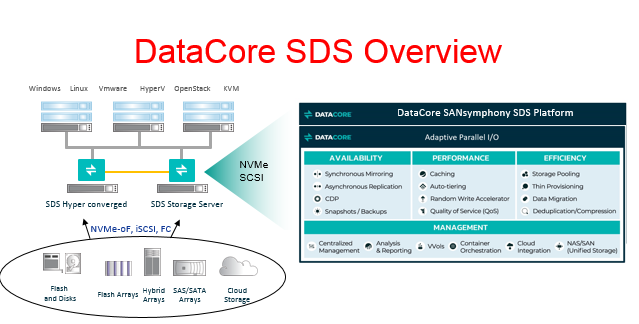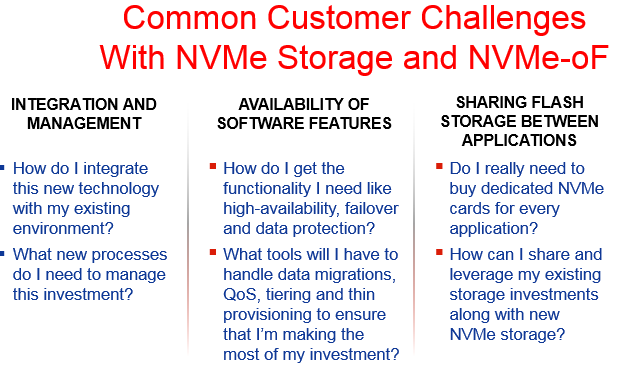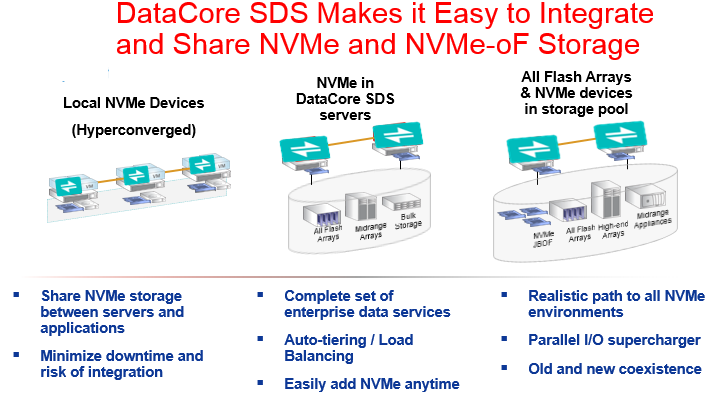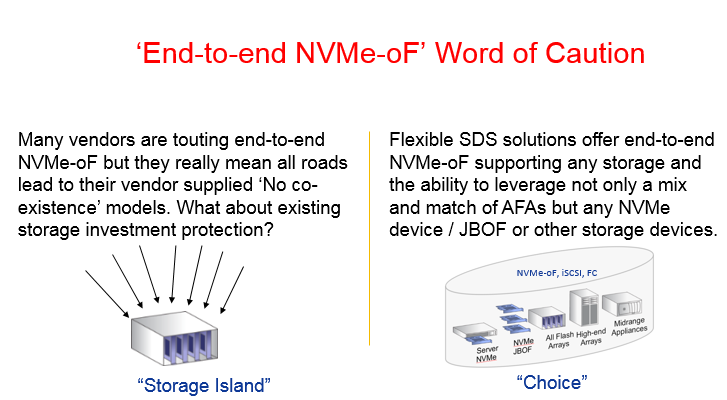The Flash Memory Summit 2018 is…well, just a memory now. But it’s a good one.
At this year’s event, I participated in a panel discussion to present, Software-Defined Storage and the Customer Path to NVMe-oF, to showcase how DataCore customers are using software-defined storage (SDS) to protect their investments and ease transitions to technologies such as NVMe and NVMe over Fabric (NVMe-oF).
NVMe and NVMe-oF technology promise new levels of performance for flash-based storage systems, but for large, distributed systems, the problem remains of deploying, managing, and migrating data and applications. Adoption of NVMe-oF has been particularly slow due to a lack of software services and an easy path for businesses to transition without suffering the costs and disruptions required to benefit from the technology. Customers are forced into a ‘rip-and-replace’ abandonment of current investments.
NVMe and NVMe-oF Need Proven Software to Accelerate Customer Adoption
SDS acts as a bridge that unifies and abstracts legacy and new storage, allowing users to seamlessly integrate new technologies like NVMe-oF and gain the benefits without having to sacrifice past investments. SDS enterprise data services delivered ‘over the wire’ with low latency impact are thus required to fuel NVMe and NVMe-oF adoption.

SDS can provide a basis for managing all types of storage at the speed required to realize the benefits of NVMe. An effective SDS solution can eliminate changes to hosts, provide quality of services, automate data migration, support NVMe with the existing fabric network, and provide a wide range of enterprise-class data services such as continuous data protection, load-balancing, HA mirroring, auto-tiering, and data migration. SDS allows for the adoption of varied implementations of NVMe, including local SSDs and NVMe-oF using standard HBAs, and end-to-end NVMe for workloads demanding minimum latency.

At the Flash Memory Summit, participants were eager to learn about how SDS and Parallel I/O technologies can overcome the challenges and disruptions that can potentially slow down the successful migration to NVMe-oF.

My presentation, Software-Defined Storage and the Customer Path to NVMe-oF, examined two current case studies describing customer adoption and integration of NVMe technology using SDS to do so without disruption. These included:
- Co-existence with existing storage: This detailed the use of NVMe-oF to co-exist with installed Flash devices and storage subsystems that use traditional protocols internally to handle I/O. Customers gain the benefit of using a proven data services software stack and lower latency over the wire, while taking advantage of existing storage subsystem technology.
- New system deployments: This application reviewed pooling and sharing NVMe devices (JBOFs) for cost savings versus AFAs. The customer is using a storage system comprised of many NVMe devices typically for ERP/database applications, using NVMe-oF with a Fibre Channel interface, making a complete end-to-end high performance, low latency NVMe storage solution.

Additionally, I previewed our initial ‘pre-tuning’ I/O meter performance, sharing slides in my presentation on the results for enterprise data services and storage delivered ‘over the wire’ and a wire trace showing less than 0.015ms latency.
Performance, simplicity of deployment, and the ability to leverage existing storage are all critical factors in easing the adoption of NVMe-oF. Many vendors are currently touting end-to-end NVMe-oF but they usually mean all roads lead to vendor supplied ‘no co-existence’ models. On the other hand, flexible SDS solutions offer end-to-end NVMe-oF – supporting any storage and the ability to leverage not only a mix and match of AFAs but any NVMe device/JBOF or other storage devices.

In summary, as we move toward the next evolution for performance and lowering latency with NVMe-oF, SDS can help dramatically improve performance and utilization, reduce down-time, and minimize cost and management complexity.
Click here to download the complete Flash Media Summit 2018 presentation!
And for related content, please see: If I Use NVMe, Why Do I Still Need Parallel I/O?